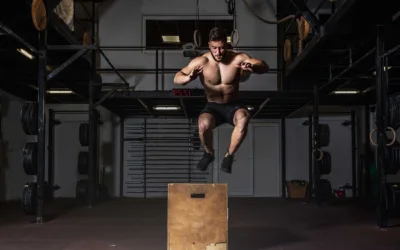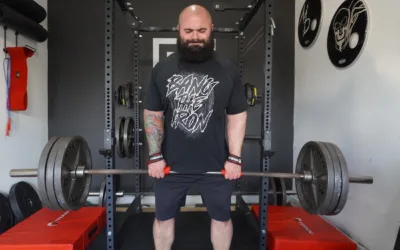Strength Training for Fencers

Whether you’re a professional, sub-elite, or hobbyist, you’ll become a better fencer by doing some strength training. Even a simple strength training program can help you become a quicker, more explosive, and injury-free athlete.
Chris Van Nostrand is the founder of Strength Wise Barbell. As a global marketing executive, strength and nutrition coach, and entrepreneur, he developed a system for balancing the demands of an intense career with raising a family and competing in powerlifting. Here, he shares his experience optimizing programs for high-level fencers.

Fencers Need Strength Training, Too
Although fencing was one of the first sports to debut at the first modern Olympics held in 1896, your strength and conditioning as a fencer needs to follow the latest research. New data shows huge potential in improved performances for fencers who use a targeted approach to strength training.
The foundation of any good strength and conditioning program is specificity. Whether you’re a beginner or an experienced fencer, you need a training program that targets the specific demands of the sport. Focusing on a few key factors (like anaerobic capacity and lunge explosiveness) will have the most carry-over to your performance and make the best use of your time.
After all, strength and conditioning should complement the actual skills practice that is going to form the majority of your training, while also leaving ample room for recovery. This is particularly important for those competing at higher levels with an extensive competition schedule and short off-season.
Coach’s note: For simplicity I’m going to assume that epee, foil, and saber all require the same base program. At more advanced training stages, further customization may be needed, but that could be a process of many years.
Training That Fits the Unique Demands of Fencing
Fencing is a unique sport with unique skills. Although these specific skills take time to master, focusing on your anaerobic capacity, strength, power, and plyometrics will help you immensely in the long-term.
Anaerobic capacity
Anaerobic means “without oxygen.” This is the type of exercise that breaks down glucose in the body without using oxygen – aka the more intense, shorter workouts. Fencers must have a large anaerobic capacity to generate quick, explosive bursts of energy repeatedly and consistently. This is far more important than steady state cardio (aerobic exercise).
High Intensity Interval Training (HIIT) will mimic the energy demands of fencing, meaning frequent, short durations of maximum effort followed by rest periods of equal length. Battle ropes, rowing, or cycling are all ideal.
Strength work
A fencer’s ideal strength routine builds force production through the upper and lower body while also providing a foundation for developing power in the attacking positions. Core compound barbell movements of deadlift, bench, and squat should be the focus. These are known as compound lifts because they provide resistance across multiple muscle groups and joints, giving you the best training bang for your buck.
The shoulder and back muscles deserve extra attention to develop explosiveness and endurance with the weapon. Likewise, you’ll want to prioritize unilateral leg work for quick reaction times off the back foot. Rotating movements like delt raises, dumbbell rows, split squats, and single-leg hip thrusts throughout your program will ensure you’re getting enough shoulder, back, and unilateral leg work.
I also need to call out the role of targeted hamstring training as well. These powerful muscles pose the greatest injury risk to fencers, but fortunately there’s plenty of excellent movements to bulletproof them. Try Romanian deadlifts, stiff-legged deadlifts, hip thrusts, glute raises, leg curls, and reverse Nordic curls to keep those hammies strong and resilient.
Coach’s tip: Check out this article for a guide to some awesome hamstring exercises, including Nordic curls and hip thrusts: 8 of the Best Hamstring Exercises for Meaty Legs
Power training
You need training that expresses strength with maximum velocity, particularly with the extension of the shoulder and arm. Research shows that elite fencers tend to achieve maximum extension earlier, independent of leg drive. Explosive movements like the power clean should form the bulk of this training.
Plyometrics
Plyos enhance reactive strength, which is essential to the acceleration, cutting, and agility fencer’s need. This is key for recovering from missed attacks and defense. Box jumps, lunges, and skater hops are great plyo moves that build explosive power.

You Work too Hard to Not See Progress
Find Your Perfect Training Plan
Options for Every Goal
Training plans from real coaches covering any goal, fitness level, and number of sessions per week.
The Best Coaches
Get coached by the best. Olympians, ex-NFL stars, Titan Games Winners, Sport Scientists and more.
Starting at $1/ day
With many options including a free 7 day trial, you can try out programming before you commit.
Find Your Minimum Effective Volume
First, remember that your priority is fencing practice and performance. This means you’ll want to focus on minimum effective volume (MEV). MEV is the least amount of work needed to produce desired results.
Volume is just a way of defining lifting work. It’s the product of total sets x repetitions. So ten sets of five reps equals a volume of 50.
I like to set volume on a weekly basis so it’s easy to organize workouts. Let’s take the bench press as an example. Ten sets of five reps would in fact be a reasonable amount of weekly volume, but a bit too much for a single workout session. Instead, it can be broken into two sessions of 5×5 per week. This keeps workouts shorter, performance fresher, and fatigue minimized.
Ten sets may seem like too little, especially if you’ve dabbled in strength training using a standard program. But our goal is to identify minimum effective volume, not find the hardest possible workout you can tolerate. Limiting volume also forces you to be more intentional and emphasize the quality of each rep.
Plus, it’s easy to add in more volume, particularly during the off-season. Scaling up is simple. But if you overreach too quickly, you’ll be dealing with extra fatigue and soreness during your practice.
One more thing to note: intensity refers to the actual weight on the bar in a given exercise, as well as how challenging the session is overall from a fitness perspective. Keep that distinction in mind.
Level Up Your Training
With TrainHeroic’s immersive training app
TrainHeroic does everything you wish your old gym notebook could do.
Take the guesswork out of training with built-in exercise instruction and basic training programs. Compete against yourself and others. Track your performance and readiness. Smash your goals.

Periodize Your Training Blocks
For example, you need to be able to execute your fencing movements with maximal strength. So, a periodization scheme for fencing would entail building strength first that can then be expressed as power in subsequent training blocks.
Here’s the base of the program.
Block 1: General Physical Preparedness
This is the training block during which you assess your capabilities and set the foundation for further training adaptations.
The barbell lifts are performed at moderate rep ranges several times per week to build a bit of strength and hypertrophy. An additional lifting session might feature higher reps of assistance lifts to build muscle in the shoulders, back, glutes, and hamstrings.
Fencers are typically at risk of hamstring injuries due to muscle imbalances and overuse of the quads in the lunge position, which makes it important to strengthen the posterior chain specifically during this block.
One session of plyometrics to start is sufficient for developing explosiveness, with High Intensity Interval Training (HIIT) incorporated as needed, based on the individual athlete. Note that steady-state cardio or aerobic conditioning is absent, and this is by design. Steady state cardio trains a totally different energy system than the one actually used during fencing. Anaerobic capacity is what provides quick, explosive bursts of energy.
The idea with HIIT is to optimize this energy system while generally becoming exposed to the demands of competition in a training environment.
Block 2: Strength Development
The next training block uses lower rep ranges of the barbell lifts with a higher percentage of your estimated maximum. Focusing on strength creates specific neural adaptations while also priming the muscles, ligaments, and tendons for the more explosive movements that will come in the next block.
The rep ranges for the assistance lifts also decrease slightly, giving you the opportunity to focus even more on hypertrophy.
HIIT training increases by ten during this block to further push conditioning. Plyometrics remain constant to avoid adding too much training volume all at once (since the intensity of the lifting is increasing).
Block 3: Power and Explosiveness
In this phase, some portion of the existing lifts are replaced by the power clean or similar movements. Essentially, you’re trading some of the strength acquired from earlier blocks as power that can translate into stronger attacks.
An additional plyometric session is added here. Again, the goal is expressing strength as power as well as agility, speed, and quickness, or reactive strength.
Depending on where you are in your season, you may want to adapt the progression of your blocks. If you’re in the midst of an extended competition window when you start training, you can run block 1 for several cycles in a row.
Also keep in mind that specificity not only refers to programming, but also the needs of the individual athlete. Remember that each athlete is different and will require different strength training needs.
Take a look at your current strength program and see if you are doing enough anaerobic, strength work and plyometric work. If not, it might be time to make some adjustments. And if you’re not doing any strength training at all, now is the time to start!
No matter your level, strength training can improve your performance. Take stock of your current program and training goals, and get ready to blow away the competition.
Want Training Tips, Exercise Guides & Knowledge Bombs Sent to Your Inbox?
Sign up for the FitNerd newsletter from TrainHeroic
Related articles
Top 6 Exercises for Managing Shoulder Injuries
What to Do for an Injured Shoulder After 6 years of coaching at the highest levels across multiple disciplines, the most common issues I see in my sports therapy clinic have to do with the shoulder. Statistics show us that shoulders are the most commonly injured area...
Ballistic vs. Plyometric: Understanding Dynamic Movements
Have you heard the Russian proverb, “once you stop jumping, you start dying”? A little dramatic and fatalistic maybe, but the basic idea centers around maintaining your body’s capacity to perform explosive plyometrics. As we age, we become more risk-averse — injuries...
Winter Warfare: How to Bulk Up This Season
It’s that time of the year to wreak havoc and prepare for a massive winter bulk! But wait, what is a winter bulk? What does it take, and how do we achieve it? Joseph Lucero (CSCS), owner of Harvesting Strength, is a powerlifter and strongman coach with years of...

Join the community
Sign up for the latest training news and updates from TrainHeroic

About TrainHeroic
Support
Made with love, sweat, protein isolate and hard work in Denver, CO
© 2021 TrainHeroic, Inc. All rights reserved.







